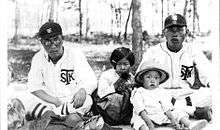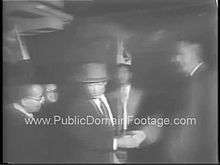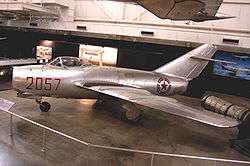No Kum-sok
| No Kum-sok | |
|---|---|
 No in the early 1950s | |
| Native name |
Chosongul: 노금석 Hanja: 盧今錫 RR: No Geum-seuk MR: No Kŭm-sŏk |
| Birth name | No Kum-sok |
| Nickname(s) | "Okamura Kyoshi" |
| Born |
January 10, 1932 Shinko, Kankyōnandō, Japanese Korea (now Sinhung County, South Hamgyong Province, North Korea) |
| Allegiance |
|
| Service/branch |
|
| Years of service | 1949–1953 |
| Rank | Lieutenant |
Kenneth H. Rowe (born No Kum-sok; January 10, 1932)[1] is a former lieutenant of the North Korean air force. A few weeks after the Korean War was over, he defected to South Korea in a MiG aircraft.
A biography of Kum-Sok was published by Blaine Harden in 2015 as The Great Leader and the Fighter Pilot: The True Story of the Tyrant Who Created North Korea and The Young Lieutenant Who Stole His Way to Freedom (2015).[2] Harden had access to newly released intelligence, and to Kum-sok.[3]
Early life and education

No was born in northern Korea when the country was occupied by the Imperial Japanese regime. His first name, "Kum", means "gold" in Korean.
Growing up as a child in Japanese-occupied Korea, No was forced by the Japanese imperialists to use the Japanese-sounding name, Okamura Kyoshi.[4]
His father was a baseball player for a company's team. During World War II, No supported Japan and considered becoming a kamikaze pilot, but his father was adamantly against it. No's support for Imperial Japan waned and he became pro-American, though he had to hide his pro-Americanism due to the dangers of being recognized as being an admirer of the U.S. in northern Korea at the time.
In early 1948, a teenage No attended a speech by Kim Il-sung. Though No was against Communism, he found Kim to be a capable orator.[5] However, No had to keep his anti-Communist views hidden, due to the danger of what would happen if North Korean authorities had found out about them.
Career


Defection
On the morning of September 21, 1953, No flew his Mikoyan-Gurevich MiG-15 from Sunan just outside Pyongyang to the Kimpo Air Base in South Korea.[6][7] The time from take-off in North Korea to landing in South Korea was 17 minutes, with the MiG reaching 1000 km/h (620 mph).[8] During the flight he was not chased by North Korean planes, nor was he interdicted by American air or ground forces;[8] U.S. radar near Kimpo had been shut down temporarily that morning for routine maintenance.[9] Kum-sok landed the wrong way on the runway, almost hitting an F-86 Sabre jet landing at the same time from the opposite direction.[7][8] Captain Dave William veered out of the way and exclaimed over the radio "It's a goddamn MiG!".[8] Another American pilot, Captain Jim Sutton who was circling the airport, said if Kum-sok had tried to land in the right direction he would have been spotted and shot down.[8] Kum-sok taxied the MiG into a free parking spot between two Sabre jets, got out of the plane and began tearing up a picture of Kim Il-sung he carried.[8]
Kum-sok received a $100,000 ($890,831 in 2014 dollars) reward offered by Operation Moolah for being the first pilot to defect with an operational aircraft, which he said he never heard of prior to his defection.[10] Kum-sok explained that North Korean pilots were not allowed to listen to South Korean radio, the leaflets broadcasting the award were not dropped in Manchuria where the pilots were based, and even if they had heard about the reward the amount of money would have been meaningless to the young Communists; he said the program would have been more effective if they had offered a good job and residence in North America. Eisenhower was against paying defectors.[11]
There were repercussions for Kum-sok's defection. According to Captain Lee Un Yong, a North Korean air force flight instructor who defected to South Korea two years after Kum-sok, General Wan Yong, the top commander of the North Korean air force, was demoted, and five of Kum-sok's air force comrades and commanders were executed.[12] One of those killed was Lieutenant Kun Soo Sung, Kum-sok's best friend and fellow pilot.[12] Kum-sok's father was already dead and his mother already defected to the South; however, he had an uncle and the fate of him and his family was never known.[12]
No's MiG-15

After Kum-sok surrendered his aircraft, it was taken to Okinawa, where it was given USAF markings and test-flown by Capt. H.E. "Tom" Collins and Maj. Chuck Yeager. The MiG-15 was later shipped to Wright-Patterson Air Force Base after attempts to return it to North Korea were unsuccessful.[6] It is currently on display at the National Museum of the United States Air Force.
Post-defection life
In 1954, Kum-sok emigrated to the United States and even met Richard Nixon. After emigrating, he anglicized his name to "Kenneth H. Rowe".[1] He was joined in the U.S. by his mother, who had been evacuated from North Korea earlier in 1951. He subsequently graduated from the University of Delaware, with degrees in mechanical and electrical engineering.[9] He married an émigré from Kaesong, North Korea, they raised two sons and a daughter, and he became a U.S. citizen.[9] He worked as an aeronautical engineer for Grumman, Boeing, Pan Am, General Dynamics, General Motors, General Electric, Lockheed, DuPont, and Westinghouse.[9][10][13]
In 1970, he learned from a fellow defector that, as punishment for his defection, his best friend, Lieutenant Kun Soo Sung was executed. He learned that four other pilots in his chain of command were also executed by firing squad. One of the pilots and a friend in his squadron became the General of the Korean People's Army. General O Kuk-ryol, who became the vice chairman of the National Defence Commission in 2009, was considered the second most powerful man in North Korea.[9][10]
In 1996, he wrote and published a book, A MiG-15 to Freedom,[1] about his defection and previous life in North Korea. Kum-sok retired in 2000 after working 17 years as an aeronautical engineering professor at Embry-Riddle Aeronautical University.[9][14]
Personal life
No speaks fluent English and currently lives in Daytona Beach, Florida. He stated that he does not regret his decision to defect from North Korea to the U.S.
In popular culture
- No's defection is the basis of one of the missions within the video game Chuck Yeager's Air Combat.
References
- 1 2 3 Rowe, Kenneth H. (No Kum-sok); Osterholm, J. Roger (1996). A MiG-15 to Freedom. McFarland & Company Inc. ISBN 0-7864-0210-5. Retrieved September 22, 2013.
- ↑ Terry Hong (March 19, 2015). "'The Great Leader and the Fighter Pilot' presents a riveting slice of North Korean history". Christian Science Monitor. Retrieved March 21, 2015.
- ↑ "The Great Leader and the Fighter Pilot: The True Story of the Tyrant Who Created North Korea and the Young Lieutenant Who Stole His Way to Freedom". Publishers Weekly. Retrieved March 21, 2015.
- ↑ http://www.pri.org/stories/2015-03-17/florida-man-escaped-north-korea-mig-15-fighter-jet
- ↑ 2015 interview
- 1 2 "The Story of the MiG-15 On Display". Factsheets. National Museum of the United States Air Force. May 12, 2015. Retrieved June 6, 2016.
- 1 2 "The MiG-15's role during the Korean War". March 14, 2015. Retrieved October 22, 2015.
- 1 2 3 4 5 6 Harden (2015), Chapter 11, Part 3
- 1 2 3 4 5 6 Lowery, John (July 2012). "Lt. No". Air Force Magazine. The Air Force Association. Retrieved May 14, 2013.
- 1 2 3 PsyWarrior.com "Operation Moolah - The Plot To Steal A MIG-15"
- ↑ Harden (2015), Chapter 11, Part 5
- 1 2 3 Harden (2015), Chapter 11, Part 4
- ↑ "Leadership." Red Star Aviation. Archived August 28, 2008, at the Wayback Machine.
- ↑ Zenobia, Keith (September 2004). "Ken Rowe, a.k.a. No Kum-Sok: A MiG-15 to Freedom" (PDF). 19 (9). Pine Mountain Lakes Aviation Association Newsletter: 1. Retrieved September 22, 2013.
Bibliography
- Blaine Harden (2015). The Great Leader and the Fighter Pilot: The True Story of the Tyrant Who Created North Korea and The Young Lieutenant Who Stole His Way to Freedom. Viking. ISBN 978-0670016570.
External links
 Media related to No Kum-Sok at Wikimedia Commons
Media related to No Kum-Sok at Wikimedia Commons